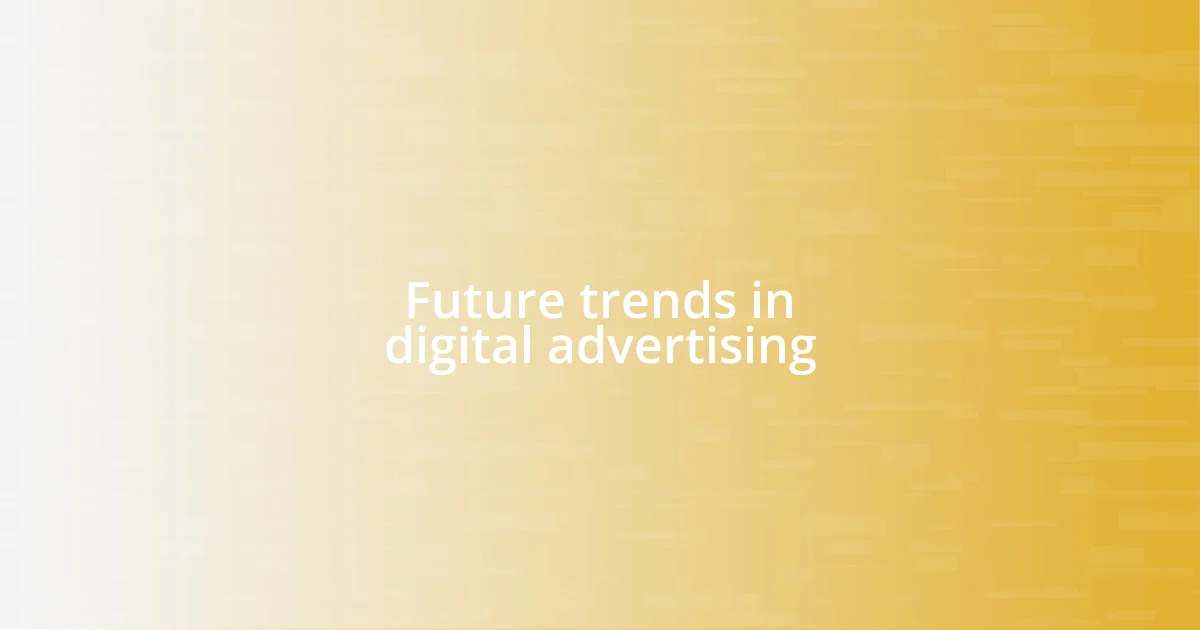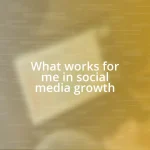Key takeaways:
- Understanding audience segmentation and tailoring ads leads to higher engagement and a sense of community.
- Continuous optimization, including A/B testing and adapting to real-time feedback, dramatically enhances campaign performance.
- Future trends like AI in targeting, immersive experiences through AR, and a focus on social responsibility are set to shape digital advertising.

Understanding digital advertising basics
Digital advertising can seem overwhelming at first, especially with so many platforms and formats to choose from. I remember when I first started—navigating Google Ads and Facebook’s targeting options felt like trying to find my way through a maze. It’s crucial to grasp the foundational elements, such as understanding the differences between pay-per-click (PPC) and display advertising, as this knowledge can make a significant impact on your campaigns.
One of the aspects I’ve found particularly fascinating is the importance of audience segmentation. By tailoring your ads to specific groups, you can create more impactful connections. I once experimented with a campaign that targeted a narrow demographic, and to my surprise, it not only delivered higher engagement rates but also fostered a sense of community among customers who felt personally understood.
The metrics in digital advertising, such as click-through rates (CTR) and conversion rates, are essential to track. Have you ever thought about how these numbers translate into real-world interactions? I vividly recall a moment when a simple tweak to my ad’s wording significantly boosted the CTR, reminding me that even small changes can lead to meaningful results. Understanding these basics empowers you to build more strategic campaigns and provides a roadmap for growth.

Key digital advertising channels
When delving into the key digital advertising channels, I’ve noticed a few standouts that seem to resonate across different campaigns. Social media platforms like Facebook and Instagram captivate audiences with rich visuals and targeted messaging. I recall running a campaign on Instagram that showcased a product in a real-life scenario; the response was exhilarating as the engagement skyrocketed, proving just how potent visuals combined with targeted ads can be.
Email marketing is another channel that I underestimated at first. Initially, I thought it was an outdated method, but once I started crafting personalized email campaigns, the engagement numbers told a different story. The enthusiasm I felt when an old subscriber finally reacted to an email I sent after months of silence was a reminder that email still holds immense potential—especially when it’s done right.
Finally, I can’t overlook the power of search engine marketing (SEM). When I initiated my first Google Ads campaign, I remember feeling a wave of excitement mixed with trepidation. Watching my ad soar to the top of search results after optimizing keywords was a thrilling moment, confirming that with the right approach, search visibility can dramatically increase traffic and conversions.
| Channel | Description |
|---|---|
| Social Media | Platforms like Facebook and Instagram are ideal for visually engaging content and targeted reach. |
| Email Marketing | A cost-effective channel designed for direct communication, allowing for tailored messaging to specific audiences. |
| Search Engine Marketing (SEM) | Using paid ads on search engines to increase visibility and drive targeted traffic based on keywords. |

Creating effective advertising strategies
Creating effective advertising strategies hinges on a few core principles that I’ve learned over time. One crucial insight is the importance of setting clear objectives for each campaign. I remember launching a campaign without a defined goal, and let me tell you, it felt like shooting arrows in the dark. But once I started delineating specific targets, like increasing website traffic or boosting product awareness, everything clicked into place. Each campaign became a focused mission, transforming my approach to digital advertising.
Here are some strategies that have worked wonders for me:
- Define Your Objectives: Understand the purpose behind your campaign to shape content and direction effectively.
- Target Your Audience: Analyze and segment your audience for more personalized and relevant ads.
- Test and Iterate: Don’t be afraid to experiment with different formats and messages; track results, and adapt.
- Budget Wisely: Prioritize spending based on which channels yield the best ROI, yet leave room for experimentation.
- Utilize Retargeting: Re-engage users who showed interest but didn’t convert—the second chance can often win them over.
Another aspect that truly stands out is the art of storytelling. I recall during one campaign, I decided to weave a narrative around my brand. Instead of just pushing a product, I shared a real-life challenge my customers faced and how my product could be their solution. The response was incredibly touching; I received messages from people who felt seen and understood. That emotional connection drove an unexpected surge in sales and loyalty. It’s these moments that remind me of the immense power of crafting a narrative in advertising.

Measuring advertising performance metrics
Measuring advertising performance metrics is crucial for understanding the effectiveness of your campaigns. When I first dived into this realm, I was overwhelmed by the sheer number of metrics available—click-through rates (CTR), conversion rates, and return on ad spend (ROAS), to name a few. Eventually, I learned to focus on what truly mattered. For instance, tracking the CTR gave me a clear indication of whether my ads were captivating enough to draw viewers in.
One of my unforgettable moments was when I analyzed a campaign using A/B testing to compare two different ad formats. The excitement was palpable as I delved into the data, only to find that one version outperformed the other significantly. This experience taught me that even small changes in imagery or wording can lead to substantial shifts in performance metrics. Isn’t it fascinating how data can reveal such profound insights?
I also discovered the importance of utilizing analytics tools, like Google Analytics and Facebook Insights. These platforms provide a treasure trove of information on audience behavior and campaign performance. I recall one campaign where I dug deep into the demographic data and realized that my audience skewed younger than I had anticipated. Adjusting my messaging to fit their preferences was a game-changer, leading to a noticeable uptick in engagement. It made me wonder—how often do we miss out on opportunities simply because we don’t analyze the right data?

Optimizing ad campaigns continuously
Continuous optimization of ad campaigns has been a revelation for me. In my early days, I would set a campaign and let it run, assuming it was doing its job. But I quickly learned that regular adjustments based on performance data can lead to significant improvements. For example, I once reconsidered my ad placement strategy midway through a campaign, switching from broader sites to more niche platforms. The difference in engagement was remarkable; my ads reached people truly interested in the product.
There’s something to be said about listening to the audience while a campaign is active. One time, I noticed a spike in interest from a specific demographic that I hadn’t targeted initially. Instead of seeing it as a missed opportunity, I pivoted my approach, tailoring ads to speak directly to that group. The positive feedback and interaction I received felt incredibly rewarding. Have you ever squeezed lemonade from a surprise influx of lemons? That’s exactly what it felt like!
I also find that using feedback loops is essential. Listening to what users say about your ads—through comments, clicks, and even direct messages—provides invaluable insights. Once, I received a message from a customer who loved a particular aspect of my ad design but felt the call-to-action was unclear. After tweaking it based on their suggestion, I saw a marked increase in conversions. Isn’t it amazing how a little bit of input from your audience can spark such substantial growth?

Navigating digital advertising challenges
Navigating the challenges of digital advertising can often feel like trying to read a map in the dark. I remember launching a new product and pouring time and resources into a campaign, only to be met with crickets. It hit me hard, but rather than retreating, I took a step back to dissect what went wrong. I started experimenting with different platforms and targeting options, and it completely transformed my approach. Have you ever been in a situation where a little pivot made all the difference?
One significant hurdle I’ve faced is dealing with ad fatigue; when audiences grow tired of seeing the same ads, engagement plummets. I recall implementing a rotation strategy, refreshing my visuals and copy every few weeks. The response was nothing short of remarkable! By keeping things fresh, I not only retained the attention of my audience but also reignited their interest. Isn’t it curious how a simple change can breathe new life into what once felt stale?
Ad blockers present yet another challenge in this landscape. At first, it frustrated me to think that many potential viewers were actively choosing to ignore my carefully crafted campaigns. However, I started to view it as a chance for innovation. I began to focus on creating value-rich content rather than just direct promotions. For example, when I launched a series of informative videos related to my niche, I noticed not only an uptick in engagement but also an increase in positive conversations around my brand. Isn’t it empowering to turn obstacles into opportunities for connection?

Future trends in digital advertising
I’m genuinely excited to share what I see as some upcoming trends in digital advertising. One area that I think is going to explode is the rise of artificial intelligence (AI) in ad targeting. I’ve seen firsthand how algorithms can analyze data patterns and create personalized content on a massive scale. Once, after integrating a simple AI tool to analyze user behavior, I was amazed at how quickly it optimized my campaigns. The specificity of the audience it identified was like having a personal shopper for my ads. Can you imagine what that means for future campaigns where the level of personalization is even more refined?
Another trend that really interests me is the shift towards immersive experiences, especially through augmented reality (AR). I remember trying out an AR feature for a product launch, allowing users to visualize a new furniture piece in their own living space. The excitement and engagement levels were tangible, much greater than traditional ads. Have you ever interacted with something that felt strikingly real? That’s the kind of emotional connection AR can foster, making consumers not just viewers, but participants in the brand story.
Finally, I can’t overlook the growing importance of social responsibility in advertising strategies. I’ve noticed that the brands that resonate with consumers often have a clear message about sustainability and ethical practices. It reminds me of a campaign I worked on that highlighted our eco-friendly initiatives; the positive response was overwhelming. It’s refreshing to see people gravitating towards brands that align with their values. Is it just me, or does it feel right to choose authenticity over mere sales pitches? I believe that as digital advertising continues evolving, this focus on genuine connection and responsibility will only become more critical.















